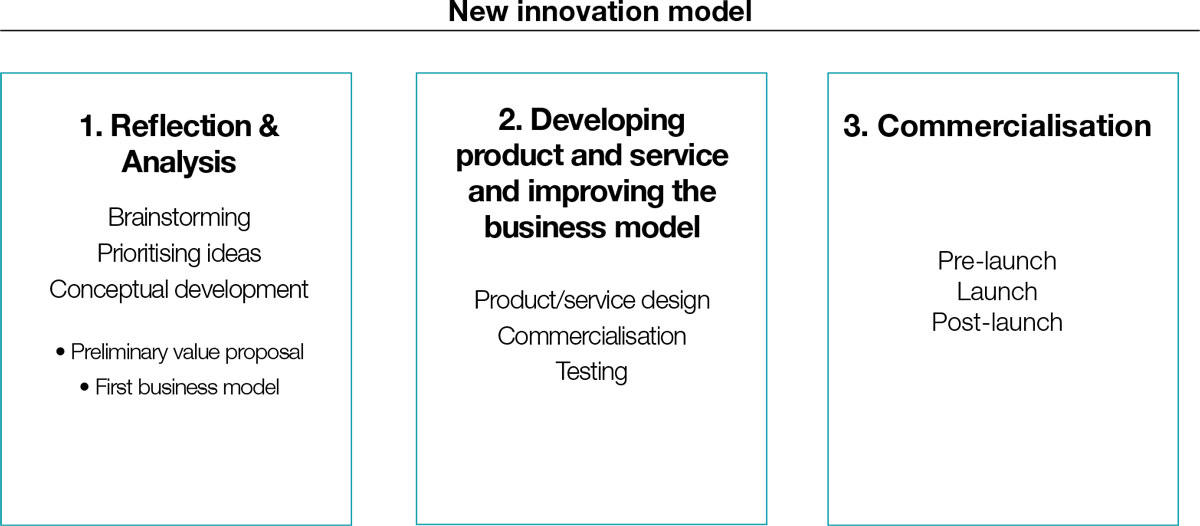connect
people
ANNUAL
REPORT
2016


Cellnex is closely linked to its strategy, and this is embodied in its mission to be the company that generates value for society, customers and shareholders, through innovative, efficient, neutral and high-quality management in delivering service and contributing technological solutions.
This commitment to R&D+i represents one of the main challenges for Cellnex in the current global context, which is characterised by its strong innovative character and global social reality that is strongly linked to the digital world and the communication technologies.
To respond to these challenges in an effective and structured way, Cellnex formally set up its Innovation and Product Strategy Department in 2016. That decision reflects an awareness that innovation is a critical activity which commits areas to cross-cutting product and service creation processes.
The Innovation and Product Strategy Department has established an R&D+i management model based on two types:
Once the types were defined, innovation moulding was performed for the R&D+i activities performed by Cellnex, bringing about more integrated and flexible processes and standardising the procedures that such activities involve.
This model also embodies a cross-cutting approach, defining working procedures in multidisciplinary teams and enhanced cooperation with the stakeholders that deal with Cellnex. Some examples of stakeholders are: technology start-ups, universities and key players from other sectors.


Notably, the innovation model is focused not only on developing new business and/or products, but also on developing incremental improvements to current services and products. In this regard, we have seen a significant increase in customer satisfaction.
This increase is driving Cellnex to continue working in line with the target of mainstreaming innovation and working with internal and external multidisciplinary teams.

Smart Cities and the Internet of Things
 GROWSMARTER
GROWSMARTER Growsmarter
A project funded by the European Commission based on transforming cities to achieve a smart and sustainable Europe. In a fully urbanised Europe, cities must adopt smart solutions to meet the needs of citizens. In this regard, the cities of Stockholm, Cologne and Barcelona aim to be the exponents of these smart cities. Cellnex assumes the role of technology partner, and focuses its efforts in three areas of action: energy efficiency, integration of infrastructure and sustainable urban mobility.
iCity
A project linked to Smart Cities, in which the cities of Barcelona, London, Bologna and Genoa are taking part, with the aim of creating a framework for collaborative development of public interest applications and services and laboratories working on Smart Cities.
Security and emergency networks
 4G-LTE Multi-standard Base Stations (EBM4G-II)
4G-LTE Multi-standard Base Stations (EBM4G-II) V2XArch:
The project is funded by the Spanish Ministry of Industry, Energy and Tourism within the National Plan for Scientific Research, Development and Technological Innovation. ITS (Intelligent Transport Systems) technology significantly increases the safety, efficiency and sustainability of transport systems, and is key to the development of Smart Cities. Cellnex poses multiple challenges regarding V2X services (vehicle-to-vehicle or vehicle-to-infrastructure): definition of architectures and technologies to deploy V2X services; analysis of business models and cases of using V2X service, and; validation of the proposals made by the company.
POLARYS (Smart platform for maritime security and emergency management)
A project funded by the CDTI in the field of maritime security to research into VDES naval technology applied to communication, using the new VHF digitalisation bands. The project will develop a novel VDES (VHF Data Exchange System) transceiver to facilitate the exchange of maritime security information between ships, and between such ships and infrastructure. This development will significantly expand the capacity of the AIS platform in terms of data rate and coverage. Once developed, the system will be validated in a real scenario.
Broadcasting
 TV-RING
TV-RINGHigh Efficiency Advanced Platform for Content Distribution (PLEASE):
The project consists of the specification, design and development of a content distribution platform using high-efficiency video encoding and dynamic content distribution. The expected results of the project are ultra high-definition television and audiovisual consumption in portable devices.
TV-RING:
A project funded by the European Commission and revolving around three pilots developed in Germany, Netherlands and Spain. The pilot on which Cellnex is focusing its efforts aims to design a multi-camera HD video service. In general, all these pilots aim to test the applications that will define the future of audiovisual services based on the Connected TV concept.

GRI: G4-DMA, G4-EC7, G4-EC8, G4-SO1, G4-SO2, PA.9, TA.1, TA.2, TA.3, TA.4
We use our own and third-party cookies to improve our services and show you advertising related to your preferences by analysing your browsing habits. If you continue to browse, we understand that you accept the use of these cookies. You can change your configuration or obtain further information Cookies Policy. Accept